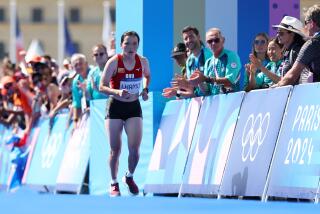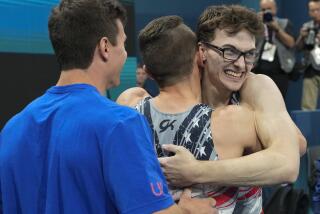Running Mates
- Share via
While watching “Endurance,” you might be tempted to draw a family tree just to keep track of who is playing whom in the film that traces distance runner Haile Gebrselassie’s journey from poverty in Ethiopia to a gold medal in the 1996 Olympics.
His nephew portrays him as a boy on the farm before Gebrselassie himself takes over the part as an adult. His sister plays his mother, his uncle is his father, among other relatives cast in the film.
When real life met what’s being billed as a “nonfiction feature,” all the rules about casting were cast aside, says Leslie Woodhead, the director and writer of the Disney movie, which opens Friday in Los Angeles and New York. For a small film, “Endurance” boasts some big names; Oscar-nominated director Terrence Malick (“The Thin Red Line”) is one of its producers (along with Edward Pressman), and footage is provided by famed Olympic documentarian Bud Greenspan.
Figuring out how to film the quasi-documentary, a true story that combines historic footage from the Olympics and reenactments, wasn’t obvious, he adds.
“I’m aghast at how slowly I worked my way toward doing this,” says Woodhead, a British documentary filmmaker. “We wanted to work with Haile in Ethiopia but hadn’t resolved how we would re-create his life. Ethiopian actors from the U.S. wouldn’t know how to milk a cow, and we thought we would have the same problem with city-dwelling Ethiopian actors.”
Within a week of Gebrselassie’s winning the gold medal in the 10,000 meters at the Atlanta Games, Woodhead traveled to Ethiopia. As he came to know the runner’s extended family, the answer became apparent.
Using the family to act out the story, “who knew more about this than anyone in the whole world,” would bring reality to it, the filmmakers thought. Still, the lack of acting experience was a concern. There is not a trained actor in the cast.
“Obviously, I had my real unease about whether they would be able to do this difficult thing,” says Woodhead, speaking from his home in London. “I was quickly astonished by the degree of reality they brought about it. These are people who haven’t seen very much, or any, TV. They aren’t trying to be Sigourney Weaver or Bruce Willis. They are being the only thing they can, and the naturalness of that shines through.
“In a couple of instances, I was quite startled. In the mother’s funeral scene, where the boy [as young Haile] is reduced to sobbing tears, I said, ‘Where did that come from?’ He said, ‘I thought about my aunt. . . .’ It struck me as an answer that Marlon Brando would have given back in 1956. It was the purest method acting.”
*
Gebrselassie, speaking via telephone from Addis Ababa, says he agreed to do the film because “who wouldn’t want to have his own life story told?” and because his story relays an important message about achievement against seemingly insurmountable odds.
After screenings of the film in Ethiopia, “everyone wanted to be like Haile Gebrselassie,” he says. “It’s a very good example for the young generation. The message is not only for the athlete. It’s very important for other people to know they can do something different.”
When the filmmakers traveled to the ’96 Olympics, they did so with just a high-concept idea: “Explore the making of a great African long-distance runner,” Woodhead says. Half a dozen leading African runners--who dominate the long-distance events--were approached, but after Woodhead met Gebrselassie, he “desperately hoped” he would win his race.
“I thought him warm, very smart, witty. He spoke decent English, and he had a fascinating story. I was rooting trackside more than anyone . . . for him to win, which he did with the last reserves of his strength and a very badly injured foot,” he says. The race is included in the film in footage shot by Greenspan.
The runner’s story has all the makings of legend. Born the eighth of 10 children, he grew up in a mud hut while working the fields and spending three hours a day fetching water for his family. His mother died when he was 10, and his father couldn’t understand his son’s obsession with running. Yet his family always considered him a “magic kid” from a very early age, Woodhead says.
In a pivotal moment that is reenacted in the movie, the 7-year-old Gebrselassie sneaks away with the family radio so that he can listen to the 10,000-meter race in the 1980 Olympics and hear Ethiopian runner Miruts Yifter win the gold medal. From that moment, he wanted to be a world-class runner.
Because “Endurance” tells the true story of a contemporary hero, Disney was interested early on in releasing the film, says Dick Cook, chairman of Walt Disney Motion Pictures. “The story is so uplifting and really a triumph of the human spirit,” Cook says. “It is inspirational and I think in the great tradition of what Disney movies have been over the years.”
Disney movies also often are known for their soundtracks, but few may be as musically diverse as this one. There is so little dialogue in the movie, it gave composer John Powell “a chance to really almost write a tone poem,” he says. For Powell, 34, the struggle was to compose music that wouldn’t patronize Ethiopians yet still please the Western ear. Using sound recorded on location as well as commercial CDs of Ethiopian music--and computer software that helped him uncover compatible keys between East and West--he found a middle yet wide-ranging ground. He would run the original music through his computer and write around it to create a pleasing sound, he says.
To the composer’s great relief, the Ethiopian musicians who have heard the soundtrack approve. “I have played with their music in such a way that they could have been very upset about it, but one singer said it feels like I’m pulling Ethiopian music into the 21st century,” he says.
With the first 23 years of his life story told, Gebrselassie, now 25, won’t be running toward any movie sets any time soon. “Doing a film is a difficult thing,” he says in carefully spoken English. “Many times, we had to do the same action. As an athlete, I like to do new things.”
More to Read
Only good movies
Get the Indie Focus newsletter, Mark Olsen's weekly guide to the world of cinema.
You may occasionally receive promotional content from the Los Angeles Times.









